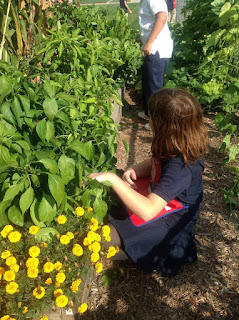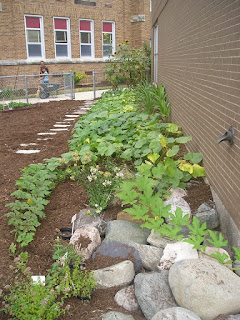| Big Orange Kitty watching over the babies |
| Small boy daydreaming next to the nursery |
One of my goals right now is to become more and more separate from industrial food. Growing lots of tomatoes seems to be one of the easiest ways to start. I used to think of tomatoes and wonder how people could eat so many of them. People who grew them in their gardens would give them away by the bags-full. I thought..just how many salads and sandwiches can I eat to use all of these before they get mushy (which happens so very quickly)? I never realized the possibility of preserving them until I tried it and saw for myself how easy it is. (If mom reads this, she may have a thing or two to say to me, namely, “Oh come on, where were you while I canned all those tomatoes every summer?” Answer: Somewhere far away from the kitchen.)
What things do I buy routinely that I could be putting up from my own tomato plants? Tomato sauce, diced tomatoes, whole tomatoes, roasted and pureed tomatoes…ketchup, even! I obtained a food mill last summer and the ease of making sauce increased ten-fold. So far I’ve done nothing more than freeze the sauce and diced tomatoes in freezer containers, but canning is next on the list of attainable goals. We use a LOT of canned tomatoes in our family, not to mention all the ketchup we go through. If we could provide the majority of our own tomatoes to last the whole year, not just in those glorious pick-them-straight-from-the-vine-and-die-of-happiness summer days, I think that would be an amazing step in the right direction.
Here are some pics of our growing tomato seedlings. They are started from seed that I got from rareseeds.com. A heritage variety called Amish Paste. The claim is that they produce well and that they make excellent sauce, so here’s to hoping!
Also! This is our 3rd garden season starting our seeds without a growlight. Countless gardening sites assume that success will only come with growlights, but if I can do without, why not? I have big windowsills to hold the trays, and by rotating the seedlings throughout the day to catch as much sunlight as possible, they seem to do okay. In one of the following pics you’ll see that on very cold days, I put a space heater (on lowest setting) under the window to keep the babies from getting frostbite. 😉
Originally posted by Andi at LittleBigHarvest
| It’s always hard to do…but it must be done. Culling the weakest sprouts so the hardiest one will grow into an amazing plant. |
| A little extra warmth on those frigid February/March mornings. |
| They eat up the sun and fill me with hope. |


 We often think of saving seeds in literal terms: letting flowers and vegetables go to seed, whether edible at that point (squash, tomatoes) or not (lettuce); separating and cleaning the seeds, drying them, and then protecting them until we’re able to plant again. But there’s a larger issue here, one that’s apparent when you consider that 94% of the seed varieties available to farmers and gardeners in 1900 have been lost, never to be grown again. Today, many of us are involved in saving seeds from extinction. To quote an old ecological saying: extinction is forever.
We often think of saving seeds in literal terms: letting flowers and vegetables go to seed, whether edible at that point (squash, tomatoes) or not (lettuce); separating and cleaning the seeds, drying them, and then protecting them until we’re able to plant again. But there’s a larger issue here, one that’s apparent when you consider that 94% of the seed varieties available to farmers and gardeners in 1900 have been lost, never to be grown again. Today, many of us are involved in saving seeds from extinction. To quote an old ecological saying: extinction is forever.



















 The story of Barnes, Schoen, and their remarkable corn is not unusual. For millennia, people have elegantly interacted with the plants that sustain them through careful selection and seed saving. This process, repeated year after year, changes and adapts the plants to take on any number of desirable characteristics, from enhanced color and flavor to disease resistance and hardiness.
The story of Barnes, Schoen, and their remarkable corn is not unusual. For millennia, people have elegantly interacted with the plants that sustain them through careful selection and seed saving. This process, repeated year after year, changes and adapts the plants to take on any number of desirable characteristics, from enhanced color and flavor to disease resistance and hardiness. Many people have contacted us looking to obtain Glass Gem seed. We are currently sold out of the small quantity we had in stock, but there are plans to grow out a substantial amount this summer. Fresh seed should be available by October 2012. In the meantime, we have set up a waiting list for all who wish to purchase Glass Gem.
Many people have contacted us looking to obtain Glass Gem seed. We are currently sold out of the small quantity we had in stock, but there are plans to grow out a substantial amount this summer. Fresh seed should be available by October 2012. In the meantime, we have set up a waiting list for all who wish to purchase Glass Gem.